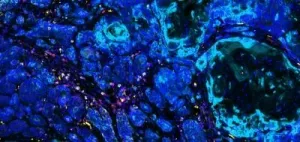Carcinogen-exposed cells provide clues in fighting treatment-resistant cancers
Researchers shed light on a potential intervention that could make tumors responsive to modern-day immunotherapies
2021-06-18
(Press-News.org) BOSTON - Researchers from Massachusetts General Hospital (MGH) have discovered a biological mechanism that transforms cells exposed to carcinogens from environmental factors like smoking and ultraviolet light into immunogenic cells that can be harnessed therapeutically to fight treatment-resistant cancers. As reported in Science Advances, that mechanism involves spurring the release of small proteins known as chemokines which, in turn, recruit antitumor immune cells (CD8+ T cells) to the tumor site to block metastasis, potentially enhancing the effectiveness of a new generation of immunotherapies.
"Immunotherapeutics have shown tremendous promise in recent years, but the fact is their response rate for many types of cancers is very low," says senior author Shadmehr (Shawn) Demehri, MD, PhD, an investigator in the Center for Cancer Immunology and the Cutaneous Biology Research Center at MGH. "We showed how cells exposed to certain carcinogens become immunogenic, that is, become targets for the immune attack, and how that exposure might be exploited to treat such major forms of cancer as breast and other epithelial cancers."
CD8+ T cells are known to effectively attack the cells exposed to environmental carcinogens. But in the past, science has focused mainly on the mutations caused by these exposures in a patient's heritable DNA as the reason for the immune attack. In their laboratory work with mice, the MGH team demonstrated for the first time another consequence of carcinogen exposure that can have significant immunologic implications, namely, the nongenetic alteration of cells through such harmful environmental factors as smoking, ultraviolet light and pollution.
"This finding is particularly important because it could open the door to therapeutic interventions that aren't practical with a DNA approach, since no clinician wants to introduce even more genetic mutations into cancer cells just to make them more immunogenic," explains Demehri. "We learned if there was another immunogenic element associated with carcinogen exposure independent of or even complementary to the presence of the mutation, then you could deliver that factor into a 'cold' tumor to make it 'hot,' meaning it would become immunogenic and responsive to immunotherapies."
That factor is a chemokine known as CCL21, which MGH researchers found to be expressed in breast cancer cells in mice that were exposed to DMBA, a carcinogen similar to that found in cigarette smoke. "Through its signaling, CCL21 recruits CD8+ T cells which infiltrate the tumor, as previous work has shown, and are associated with a significant reduction in relative risk of distant metastasis," says lead author Kaiwen Li, MD, an investigator in MGH's Center for Cancer Immunology, MGH's Cutaneous Biology Research Center and the Department of Urology at Sun Yat-sen Memorial Hospital at China's Sun Yat-sen University. "Not only does CCL21 induce an antitumor immune response to prevent metastasis, but it overcomes other immune cells known as Tregs (immunosuppressive regulatory T cells) present in tumors from inhibiting the work of the CD8+ T cells."
As an example of how this unique mechanism could be used therapeutically, the MGH team reported that an injection of CCL21 into the tumor might be able to transform cold breast cancers into hot tumors responsive to current immunotherapies.
"We hope that researchers will use these findings to open a much wider field of investigation into cancer immunology," emphasizes Demehri. "Specifically, studies are needed to identify the full array of cytokines and chemokines that are induced by environmental carcinogens in various types of cancers with the goal of harnessing the most potent mediators of antitumor immunity."
INFORMATION:
Demehri is an associate professor in the Department of Dermatology at Harvard Medical School and director of the High Risk Skin Cancer Clinic at MGH. Li is an associate professor in the Department of Urology at Sun Yat-sen Memorial Hospital. Other co-authors include Tiancheng Li, MD, Zhaoyi Feng, MD, and Mei Huang, PhD, with the Center for Cancer Immunology and the Cutaneous Biology Research Center at MGH.
The research was supported by the Breast Cancer Research Foundation, the Burroughs Wellcome Fund, the Breast Cancer Alliance, the Sidney Kimmel Foundation, the Cancer Research Institute and the National Institutes of Health.
About the Massachusetts General Hospital
Massachusetts General Hospital, founded in 1811, is the original and largest teaching hospital of Harvard Medical School. The Mass General Research Institute conducts the largest hospital-based research program in the nation, with annual research operations of more than $1 billion and comprises more than 9,500 researchers working across more than 30 institutes, centers and departments. In August 2020, Mass General was named #6 in the U.S. News & World Report list of "America's Best Hospitals."
[Attachments] See images for this press release:

ELSE PRESS RELEASES FROM THIS DATE:
2021-06-18
CHICAGO --- Scientists have long known the brain's hippocampus is crucial for long-term memory. Now a new Northwestern Medicine study has found the hippocampus also plays a role in short-term memory and helps guide decision-making.
The findings shed light on how the hippocampus contributes to memory and exploration, potentially leading to therapies that restore hippocampal function, which is impacted in memory-related aging and neurodegenerative diseases such as dementia, the study authors said.
In the study, scientists monitored participants' brain activity and tracked their eye movements while looking at different complex pictures. The scientists discovered ...
2021-06-18
Birds build nests to keep eggs and baby nestlings warm during cool weather, but also make adjustments in nest insulation in such a way the little ones can keep cool in very hot conditions. Mammals, such as rabbits or groundhogs, sleep or hibernate in underground burrows that provide stable, moderate temperatures and avoid above-ground conditions that often are far more extreme outside the burrow.
Michael Dillon, an associate professor in the University of Wyoming Department of Zoology and Physiology, was part of a research group that examined animals' ability to respond to climate change likely depends on how well they modify their habitats, ...
2021-06-18
BIRMINGHAM, Ala. - A comprehensive health-screening program in rural northern KwaZulu-Natal, South Africa, has found a high burden of undiagnosed or poorly controlled non-communicable diseases, according to a study published in The Lancet Global Health.
Researchers found that four out of five women over the age of 30 were living with a chronic health condition, and that the HIV-negative population and older people -- especially those over 50 -- bore the higher burden of undiagnosed or poorly controlled non-communicable diseases such as diabetes and hypertension.
The study was co-led by Emily Wong, M.D., a resident faculty member at the Africa Health ...
2021-06-18
Irvine, CA - June 18, 2021 - A new study paves the way for the development of next generation therapeutics for the prevention and treatment of Clostridioides difficile infection (CDI), the most frequent cause of healthcare-acquired gastrointestinal infections and death in developed countries.
Published today in Nature Communications, the study reveals the first 3D structure of the Clostridioides difficile toxin B (TcdB) in complex with chondroitin sulfate proteoglycan 4 (CSPG4), a human receptor. The study was co-led by senior author Rongsheng Jin, PhD, a professor in the Department of Physiology & Biophysics at the University of California, Irvine, School of Medicine, and Min Dong, PhD, an associate professor at Harvard Medical School.
"TcdB is one of two homologous C. ...
2021-06-18
June 18, 2021 - An experimental artificial heart includes an autoregulation control mechanism, or Auto-Mode, that can adjust to the changing needs of patients treated for end-stage heart failure. Outcomes in the first series of patients managed with the new heart replacement pump in Auto-Mode are presented in the ASAIO Journal, official journal of the American Society for Artificial Internal Organs. The journal is published in the Lippincott portfolio by Wolters Kluwer.
The study reports on the response to "pressure sensor-based autoregulation of blood flow" in ten patients for up to two years after implantation of the Carmat Total Artificial ...
2021-06-18
The visual thalamus is classically known to relay visual stimuli coming from the retina to the cerebral cortex. Researchers from the Max Planck Institute of Neurobiology now show that although neurons in the mouse visual thalamus connect to both eyes, they establish strong functional connections only with one retina. These results settle partly contradictory results of earlier studies and demonstrate how important it can be to complement structural data with functional analyses.
We have two eyes, but perceive the tree in front of us only once. Our brain therefore has the complicated task of combining the information of both eyes in a meaningful way. To do so, visual stimuli first travel from the retina via so-called ganglion cells to the visual thalamus. There, the information does end up ...
2021-06-18
June 18, 2021 - At least so far, the currently limited research base does not establish that cannabis has additional adverse effects on brain development or functioning in adolescents or young adults with attention-deficit/hyperactivity disorder (ADHD), concludes a review in the July/August issue of Harvard Review of Psychiatry. The journal is published in the Lippincott portfolio by Wolters Kluwer.
While ADHD is clinically defined to have impairments in cognitive functioning, cannabis use by itself is also associated with cognitive impairments: "[T]he evidence to date does not clearly support either an addictive effect or an interaction - whether protective ...
2021-06-18
After graduating or leaving college, many students face a difficult choice: Try to pay off their student loans as fast as possible to save on interest, or enroll in an income-based repayment plan, which offers affordable payments based on their income and forgives any balance remaining after 20 or 25 years.
There are pros and cons to each option, and trying to discern the better path can be daunting. That's why University of Colorado Boulder's Yu-Jui Huang and Saeed Khalili, a former graduate student in financial mathematics, along with Dublin City University's Paolo Guasoni, decided to throw a little mathematical ...
2021-06-18
HOUSTON - (June 18, 2021) - To boost employees' creativity, managers should consider offering a set of rewards for them to choose from, according to a new study by management experts at Rice University, Tulane University, the University of North Carolina at Greensboro and National Taiwan Normal University.
The study, co-authored by Jing Zhou, the Mary Gibbs Jones Professor of Management and Psychology at Rice's Jones Graduate School of Business, is the first to systematically examine the effects of reward choice in a field experiment, which was conducted in the context of an organizationwide suggestion ...
2021-06-18
MINNEAPOLIS/ST. PAUL (06/18/2021) -- University of Minnesota Medical School researchers determined that the common blood pressure medication, losartan, is not effective in reducing hospitalization for mildly-ill COVID-19 outpatients.
In the multicenter, randomized, double-blinded clinical trial, non-hospitalized patients recently diagnosed with COVID-19 were given either losartan or a placebo and monitored for 15 days. The study's results, which were published in END ...
LAST 30 PRESS RELEASES:
[Press-News.org] Carcinogen-exposed cells provide clues in fighting treatment-resistant cancers
Researchers shed light on a potential intervention that could make tumors responsive to modern-day immunotherapies




